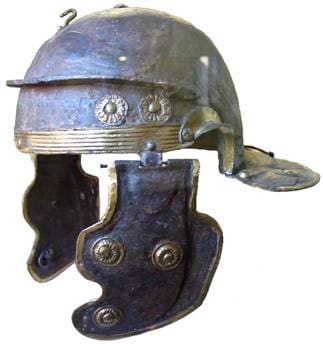What we currently refer to as high cut helmets were once commonplace. For instance, during the Roman era, many versions of the Galea or helmet featured cut outs for the ear.

(photo from Roman Hideout)
Even in the modern era, the US Army experimented with the concept during the Vietnam conflict.
This photo, taken in August, 1969 at Camp Pickett, VA, depicts a Soldier wearing a Lightweight Individual Clothing And Equipmen (LINCLOE) helmet prototype. Several versions were evaluated, made from nylon or titanium.



Has anyone compiled a study on injuries sustained on troops wearing high cut helmets versus a standard MICH or Marine Corps Lightweight helmet? I understand modern comms are much easier to use with the new helmets, but the trade off is less coverage. I’m genuinely curious. I’m not asking because I’m an internet commando.
I’m not sure how you would go about that in an honest study. Vastly differing numbers of people using each, different jobs, different injury patterns and mechanisms. You would have to have huge numbers to be able to balance / norm all of that. When you look at things like SOCOM focusing on bump protection, it’s because they have experience high numbers of injuries due to the way they work, and it might not apply to the vast majority of soldiers. Like wise others might be more subject to blast/ fragmentation and not need the mobility and adaptability of a SOCOM style helmet, but requiring more coverage.
I tend to think of it as a continuum from an EOD blast helmet to a Protec , but even that is simplified. People need different things to do different jobs……
There’s politics/a$$-covering that also makes an objective study difficult to achieve. When our SOTF lost a man to small arms fire, the investigating major from higher HQ assessed that a contributing factor was that SOF operator’s preference to wear a plate carrier, without a larger soft armor vest. The bullet entered his body just below the plate.
The push-back from our SOTF when his draft report was released was intense. I strongly suspected it was because that conclusion was likely to trigger a re-assessment of PPE worn by SOF in the entire AOR. The major acknowledged he was not an expert on the matter and backed down, and that part of his report was removed from the final version.
I suspect a study of high-cut vs. traditional helmet correlation to injury would be similarly challenged. The reports you would use to complete your study would be the final versions of those investigations. Any preliminary assessment that put some blame on the high-speed, low-drag helmet could very well have been removed under pressure, and would not be available to an outside reviewer looking at the problem today.
That upper photo, I showed it to my Dad and he says its the helmet he was issued during the War in Gaul. Do you have his shield and gladius also?
A couple of years ago I remember reading an interview of a combat surgeon in Iraq who stated that the rate of TBI increased with the introduction of the MCH and ACH, specifically injuries to Cerebellum.
For those interested here is an excellent article on ballistic helmets:
Ballistic helmets – Their design, materials, and
performance against traumatic brain injury:
http://digitalcommons.unl.edu/cgi/viewcontent.cgi?article=1200&context=usarmyresearch
I would suspect the increase in the rate of TBI is directly proportionate to the increase in effective use and design of IEDs by the enemy. Also, the increase in efficient up-armor vehicles allows soldiers to survive to have TBI. Just my take, but from my experience there was a HOOOGE difference between the IEDs/VBIEDs I faced in 2004 vs 2006-07 and on.
Right before deployment we were RFI’d the new ACH. The people fitting it put the top cushion in mine that made it ride above my forehead. I preferred my K-pot as I felt it provided more protection. Luckily for me, my Brigade chose to stick with the Kevlar instead of the new ACH.
The Army’s move to the improved ACH has worried me as they always talk about weight and not protection. If we’re reducing protection at all it shouldn’t be an option. An AK bullet should be the minimum requirement.
It offers the same level of protection.
If only there were different sizes of helmets or velcro on the pads to allow for a customized fit.
Please return my Imperial Gallic G helmet. I need to clear Xanten CIF ASAP. My Centurion has me on crucifixion detail till its found.
LMFAO
More interesting than the protype helmet in the picture is the soldier’s hand/fingernails. Or is that a protype woman’s combat manicured hand?
DADT???
Ambidextrous fingers through guitar player ? Lol
Style not through